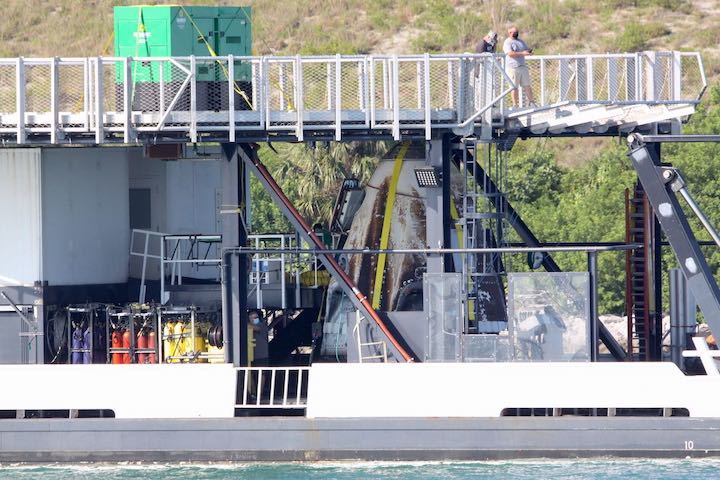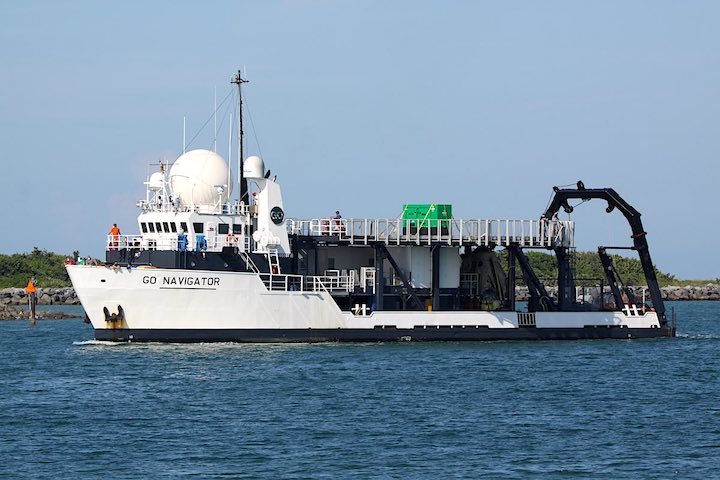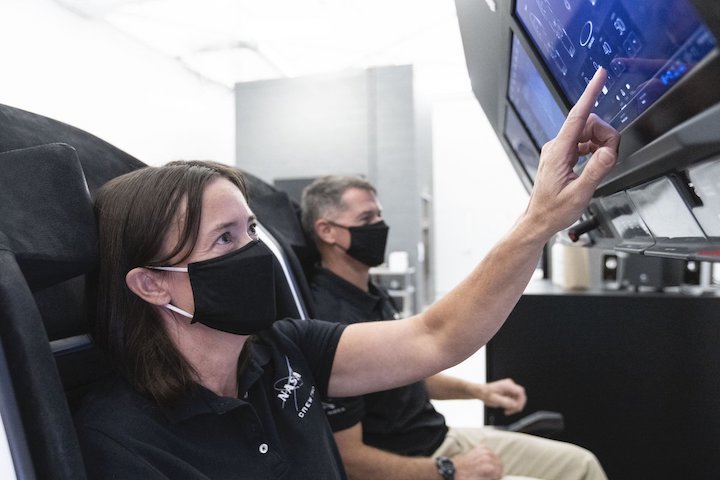14.08.2020

Fresh off a 64-day test flight to the International Space Station with astronauts Doug Hurley and Bob Behnken, SpaceX’s first human-rated Crew Dragon spaceship is back at Cape Canaveral for inspections, refurbishment and upgrades before flying to the station again with a four-person crew next spring.
The crew capsule — named “Endeavour” by Hurley and Behnken — arrived at Port Canaveral on Aug. 7 aboard SpaceX’s “Go Navigator” recovery ship after sailing from the Gulf of Mexico, where the Dragon spacecraft splashed down under parachutes Aug. 2 south of Pensacola, Florida.
The splashdown punctuated a successful demonstration flight to the International Space Station. The test flight, designated Demo-2, was the first Crew Dragon mission with astronauts on-board. NASA plans to review data from the Demo-2 mission before formally certifying the Crew Dragon for regular crew rotation flights to the space station beginning later this year.
SpaceX and NASA personnel aboard the recovery ship assisted Hurley and Behnken in getting out of the spacecraft after it was hoisted onto the vessel. While the astronauts returned to Houston by air, SpaceX’s recovery ship returned to Port Canaveral on Florida’s east coast, where engineers and technicians waited to transfer the Crew Dragon spacecraft to a processing facility at Cape Canaveral Air Force Station.
SpaceX has built a new Crew Dragon spacecraft for the company’s first operational crew rotation flight to the space station this fall. That mission, known as Crew-1, will carry NASA astronauts Mike Hopkins, Victor Glover, Shannon Walker, and Japanese astronaut Soichi Noguchi on a roughly six-month mission to the station.
The second regular Crew Dragon flight set for launch as soon as next March. Earlier this year, SpaceX and NASA agreed to re-fly the Crew Dragon from the Demo-2 test flight on the Crew-2 mission next year.
SpaceX is under contract to fly six of these “post-certification missions” for NASA through the mid-2020s. NASA has a similar contract with Boeing for six crew rotation flights on the Starliner crew capsule, which has yet to launch on a test flight with astronauts.

SpaceX will refurbish the Crew Dragon spacecraft in a facility known as Area 59 at Cape Canaveral Air Force Station. Once used to ready Air Force GPS navigation satellites for launch, the Area 59 site is now under SpaceX management for the Crew Dragon program.
While SpaceX’s past space station cargo missions using an earlier Dragon design ended with splashdowns in the Pacific Ocean off the coast of California, managers moved the returns of Crew Dragon flights to locations in the Atlantic Ocean or Gulf of Mexico off the Florida coast, closer to the refurbishment facility at Cape Canaveral. The Demo-2 mission splashed down in the Gulf of Mexico due to weather concerns in the Atlantic from Hurricane Isaias.
“The capsule is designed for five to 10 missions,” said Gwynne Shotwell, SpaceX’s president and chief operating officer. “We’ll have to see how things work out after we examine the capsule when it gets back to port and back to the Cape to our facilities there, but based on the telemetry and any visible indications that we’ve had so far, the vehicle looks like it’s in really good shape.”
Steve Stich, manager of NASA’s commercial crew program, said SpaceX’s proposal to reuse the Crew Dragon spacecraft “looked like it was a reasonable thing to do.”
“I think part of the question was how long does it take refurbish the vehicle,” Stich said. “It takes about four months or so. We have a lot of margin getting to the flight in the spring timeframe for Crew-2. The vehicle … as gets back to Area 59 at the Cape, it’ll start going through its maintenance.”
Stich said NASA will follow along with SpaceX’s maintenance, “just to make sure that there’s nothing untoward.”
SpaceX originally proposed reusing Crew Dragon spacecraft on astronaut missions when NASA selected the company to develop and fly its crew capsule in 2014. At that time, SpaceX intended to return Crew Dragons to propulsive landings on shore, rather than splashdowns at sea.
SpaceX later nixed that idea, and the company and NASA agreed to fly new Crew Dragon vehicles on astronaut missions. But SpaceX gained experience in refurbishing Dragon cargo capsules after splashdowns in salt water, and NASA said in June it agreed to fly astronauts on reused Crew Dragon spaceships and previously-flown Falcon 9 rocket boosters.
NASA Administrator Jim Bridenstine said the agency’s agreement to fly astronauts on reused capsules fits with NASA’s strategy.
“Our desire as an agency has been for sustainability, and that means reusability,” Bridenstine said.
SpaceX teams at Cape Canaveral will remove the exterior panels from the Crew Dragon spacecraft, and begin inspections to assess how the spacecraft weathered its 64-day space mission, according to Benji Reed, SpaceX’s director of crew mission management.
“We want to make sure that we kind of dig deep and understand everything that’s gone on with this vehicle, make sure we’re really ready to go, and then do some of the aspects of the refurbishment,” Reed said. “There are some things that we will replace, some things that are standardly replaced, some things that we want to upgrade based on lessons learned, or that were already planned in work.”
SpaceX will still need to build a new trunk for each Crew Dragon mission. The trunk is an unpressurized module mounted to the rear of the Crew Dragon capsule, providing electrical power with solar arrays, and radiators to maintain steady temperatures inside the spaceship.
The trunk is jettisoned before re-entry and burns up in the atmosphere.
“We have to produce a new trunk for each flight,” Reed said. “For this flight, we’ll have upgraded solar panels.”
Otherwise, Reed said the Crew Dragon spacecraft will be “almost entirely reused,” other than a few things that will be upgraded or replaced.
SpaceX says reusing spacecraft — like recovering and reusing rockets — comes not just with economic benefits, but also improvements in reliability.
“You learn so much from a vehicle that can re-fly, and you also have to build it better,” Reed said. “You have to build it more robustly for a vehicle that you know that you need to use multiple times.”
SpaceX will also fly a variant of the Crew Dragon spacecraft for resupply missions to the space station. The crew and cargo versions are collectively known as the Dragon 2 design, building on the first-generation cargo-carrying Dragon 1 spacecraft, which SpaceX retired earlier this year
“We are building out a fleet of Dragon 2s, but cargo version and crew version,” Shotwell said. “We want to wait and see how many we have to build before we say we’re done building out the fleet. We want to see how this vehicle looks after we get the opportunity to inspect it and such, but we do anticipate building out the fleet.”

NASA announced astronaut assignments for the Crew-2 mission last month.
Veteran astronaut Shane Kimbrough will command the Crew-2 mission. He has logged 189 days in orbit on two previous missions to the International Space Station, first aboard a NASA space shuttle, and then a six-month expedition in 2016 and 2017 during which he launched and landed on a Russian Soyuz spacecraft.
NASA astronaut Megan McArthur, a veteran of a nearly 13-day space shuttle flight in 2009, will serve as pilot of the Crew Dragon spacecraft. McArthur is married to Bob Behnken, who just completed his flight on the same Crew Dragon spacecraft.
“Megan is first and foremost an astronaut when it comes to our perspective,” Shotwell said.
“We will make sure that that vehicle is as good or better than the vehicle that Bob flew in … What we did for Bob, I think we can do an even better job for Megan, and I hope she is really excited to fly in this particular capsule. I was really excited to have her named the pilot for the Crew-2 mission.”
“It’s definitely her turn to focus on getting her mission, while I take care of the things that need to be taken care of for our home life,” Behnken said last week.
Japanese astronaut Akihiko Hoshide and European Space Agency astronaut Thomas Pesquet will accompany Kimbrough and McArthur on the Crew-2 mission. Hoshide and Pesquet are experienced space fliers with long-duration space station expeditions to their credit.
The Crew-2 astronauts will make up part of the space station’s crew during their planned six-month mission. The other three crew members will launch on a Russian Soyuz spacecraft, bringing the total station crew complement to seven.
Quelle: SN
